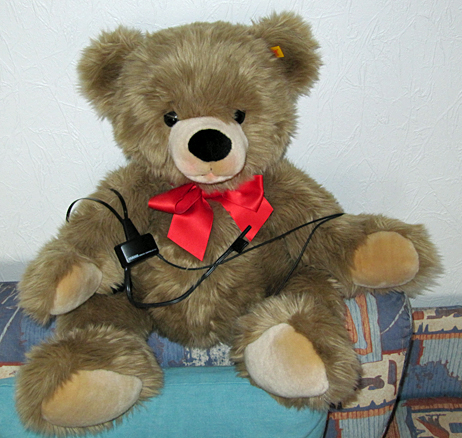

H O W I T W O R K S
Many thanks to Daniel Forró for his contributionYamaha DX7 synth was released in 1983. Its sound generating principle is called "algorithm synthesis" - it is a combination of Frequency Modulation (FM) synthesis, based on John Chowning research at Stanford University (California-USA) and additive synthesis. This synth was the first one which permitted to create very clear, bright metallic, plucked and percussive sounds; a sort of revolution comparing to analog synthesizers from the early 80's.
Basic
architecture of the sound engine is the "algorithm" - a combination of six "operators" producing sine waves. Some operators can be used as a
carrier or a modulator depending on their position in the structure of the algorithm
(there are 32 algorithms on the DX7). For
example,
algorithm 5 combines additively three pairs of carrier/modulator,
while algorithm 32 has 6 carriers only and is good for making
organ sounds.
You
can set
the frequency of each operator independently in tuned "keyboard mode"
(common tempered scale on the whole keyboard) or in "fixed
frequency mode" (the same pitch on all keys).
Operator frequency can coarse and fine tuned - in the "keyboard mode"
as a ratio, in fixed frequency mode in Hertz. In
both modes you can detune each operator to get a
subtle chorus or flange effect. One operator in each of the 32
algorithms has its output fed back to its input (or to the input of
some lower operator in the operator stack). By increasing the "feedback" level, the level of harmonics is increased, resulting
in the generation of sawtooth wave. It's also useful for generating the
noise when modulation index is enough high (= high level of modulator).

Here is THE famous DX7 !!
Each
sound operator has its own amplitude envelope generator with eight
parameters ("rate" 1 through 4 and "level" 1
through 4) which allows to create 5-segment envelope (also inverted
one). It can be considered as an improved ADSR envelope commonly
found on analog synthesizers. It's also possible to adjust
independently output
level, rate scaling and amount of velocity control for each sound
operator.
The keyboard scaling is very elaborated on the DX7: you can assign a "breakpoint"
key for each sound operator and determine if the operator level will be
increased or decreased linearly or exponentially for the left side and
the right side from the breakpoint. This function can be used
to create crossfaded sounds or simulate split keyboard.
There's
also a pitch envelope
(with the same parameters as the amplitude envelope but with level
offset of 50 to allow positive and negative pitch change) and a LFO
(which produces low-frequency sine, saw-tooth or square waves, or a Sample&Hold waveform) that you
can assign to modulate pitch, timbre or amplitude.

Algorithm, EG/Pitch & Keyboard Level Scaling schema
- DX1: two DX7 engines, wooden keyboard with polyphonic aftertouch, lot of displays (1983)
- DX5: two DX7 engines, more simple design than DX1, 76 keys (1985)
- TX816: rack with 8 TF1 modules (= DX7) with individual MIDI ports and outputs (1985)
- TX216: rack with 2 TF1 modules and possibility to add more of them (1985)
- DX7s: improved sound quality and a few other updates (1987)
- DX7II-D: upgraded the sound quality from 12 to 15 bit, performance mode, increased the number of voices to 64, stereo output (1986)
- DX7II-FD: same as the DX7II-D but with a floppy disk drive integrated (1986)
- DX7 Centennial - limited special series of DX7II-FD (1987)
- TX802: rack version of the DX7II-D with 8-part multimode and individual audio outputs (1988)

You can control and modulate DX7 sounds with a breath controller
| DX7 Soundbanks Listing | DX7 Famous Examples | DX7 All The Web Patches | DX7 Video Demos |
©2010-2025 Bobby Blues. All Rights Reserved.

